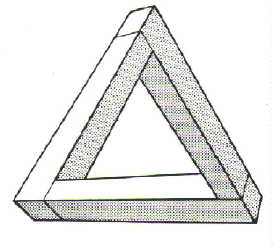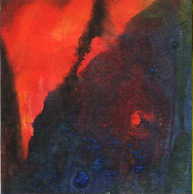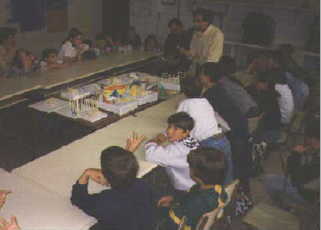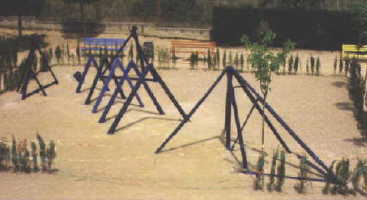But how
can this be done?
Bringing our pupils closer
to art and to the thinking skills can be done in different ways depending
on the ages, objectives and the context, in wich these different schools
activities are carried out. This doesn't mean that a series of criteria
can't be stablished to guide the focussing of the actions carried out within
the project. Some of these criterias make a reference to methodological
aspects wich we consider to be fundamental:
"Tribar". R. Penrose
 UNIT
AND INTERDEPENDENCY
UNIT
AND INTERDEPENDENCY
We have simbolized it with the image of a triangle because the three
apexes are directly interrelated in themselves:
. we can know things about art
and the artists,
. we can ask ourselves questions
and speak
about artistic works,
. we can participate in processes
of creation.
Each one of these aspects has a wider meaning when it contains the
other two: it is not only knowing things about the artist as in the traditional
style of teaching which, from a book, explained his/her life and characteristics,
but we are really concerned with here is from the point of actually knowing
an artwork of the artist the children are motivated to find out more about
him/her.
Painting for the school magazine...
 GLOBALITY
GLOBALITY
Creative activities and reflection on all of this can be done within
all the confines of the school life, from the typically curricular ones
to other that, without being directly mentioned in the planning of the
school timetables, they make up an important part of the life of the class
and the centre: posters, celebrations, games, ... From this point of view,
we belive it is important to promote the use of various languages in each
of the schools activities, and to seek in each subject its very own artistic
vessel so as to convey to the children that there are many ways of expressing
and understanding reality, and that some of them place us in direct contact
with art.
LIVING IN DIRECT WITH ARTWORKS
As we usually work the art with reproductions, photographs,
MACBA. Nov. 1996
 slides,
etc., we can see how important it is for our pupils to approach art in
a living form. This means using two directions: one that involves taking
the children on excursions to museums, exhibitions, etc. to see artworks;
and the other to bring artistic products that we have scope, to the school.
It should also be pointed out that the word "see" should be understood
in a much wider sense: see and live, touch, speak about, feel, draw, etc.,
all of these actions allow a continuity of activities that bring about
a living approach to the artistic work.
slides,
etc., we can see how important it is for our pupils to approach art in
a living form. This means using two directions: one that involves taking
the children on excursions to museums, exhibitions, etc. to see artworks;
and the other to bring artistic products that we have scope, to the school.
It should also be pointed out that the word "see" should be understood
in a much wider sense: see and live, touch, speak about, feel, draw, etc.,
all of these actions allow a continuity of activities that bring about
a living approach to the artistic work.
Performing a watch...
 OTHER
LANGUAGES
OTHER
LANGUAGES
We have worked with different languages as much in the approach to
the artworks by the children as in the productions of aspects that they
suggest to them. Not only have we worked with the oral and written form
but also with the body, with music, with volume, colour and movement. Each
one of these languages or forms of expression has its own codes, so sometimes
they have used them in the conventional way and at other times as a possible
means of exploring systems or ways of communication. At the ages with which
we work, the emphasis is not so much on the formalizing of different languages
as on the ludic use and expression of these.
THE ROLE OF THE PHILOSOPHY
Up to now, philosophy has been worked basically through texts, stories
and situations that suggest us questions, doubts, commentaries,... in a
collective effort to reach a wider  understanding
of the debated topic. The respectful dialogues that develop skills of thinking
and socialization is the centre of philosophical activity, the final objective
and method of work. We have seen that this dialogue is strengthened greatly
when some artwork was used as the starting point with a significant enrichment
of the sources and strategies of thinking used. To put this more concisely,
besides the mind being involved directly so too were the feelings. This
shows that esthetics can be treated as material for school work, as from
even a very early age, it provides the possibility of reflecting on beauty
at all levels.
understanding
of the debated topic. The respectful dialogues that develop skills of thinking
and socialization is the centre of philosophical activity, the final objective
and method of work. We have seen that this dialogue is strengthened greatly
when some artwork was used as the starting point with a significant enrichment
of the sources and strategies of thinking used. To put this more concisely,
besides the mind being involved directly so too were the feelings. This
shows that esthetics can be treated as material for school work, as from
even a very early age, it provides the possibility of reflecting on beauty
at all levels.
PERFORMANCE AND PARTICIPATION
Although we haven't had these criterias (one of the apexes of
Sculpture in the playground 5th course
 the
triangle wich is to participate in the processes of creation), we are convinced
that the strenght of the facts has been imposed them. Living artworks produces
without doubt, a side that is of a particular esthetic pleasure and of
reflections being in themselves more or less apropiate, a necessity to
participate in the processes of creation and expression. After visiting
an exhibition or working with a some artworks, many children feel the need
to paint, to mould, to write... in conclusion, to do something that allows
them to express some feeling or living experience, to try to express easily
some idea that has come to them, to experiment with materials and new techniques
or known ones.
the
triangle wich is to participate in the processes of creation), we are convinced
that the strenght of the facts has been imposed them. Living artworks produces
without doubt, a side that is of a particular esthetic pleasure and of
reflections being in themselves more or less apropiate, a necessity to
participate in the processes of creation and expression. After visiting
an exhibition or working with a some artworks, many children feel the need
to paint, to mould, to write... in conclusion, to do something that allows
them to express some feeling or living experience, to try to express easily
some idea that has come to them, to experiment with materials and new techniques
or known ones.
If you are
interested in some of these methodological aspects or you want to know
about our working standards within the "PECA" Project you can contact
us. Soon we will have some published materials...
 GLOBALITY
GLOBALITY
 UNIT
AND INTERDEPENDENCY
UNIT
AND INTERDEPENDENCY
 slides,
etc., we can see how important it is for our pupils to approach art in
a living form. This means using two directions: one that involves taking
the children on excursions to museums, exhibitions, etc. to see artworks;
and the other to bring artistic products that we have scope, to the school.
It should also be pointed out that the word "see" should be understood
in a much wider sense: see and live, touch, speak about, feel, draw, etc.,
all of these actions allow a continuity of activities that bring about
a living approach to the artistic work.
slides,
etc., we can see how important it is for our pupils to approach art in
a living form. This means using two directions: one that involves taking
the children on excursions to museums, exhibitions, etc. to see artworks;
and the other to bring artistic products that we have scope, to the school.
It should also be pointed out that the word "see" should be understood
in a much wider sense: see and live, touch, speak about, feel, draw, etc.,
all of these actions allow a continuity of activities that bring about
a living approach to the artistic work.
 OTHER
LANGUAGES
OTHER
LANGUAGES
 understanding
of the debated topic. The respectful dialogues that develop skills of thinking
and socialization is the centre of philosophical activity, the final objective
and method of work. We have seen that this dialogue is strengthened greatly
when some artwork was used as the starting point with a significant enrichment
of the sources and strategies of thinking used. To put this more concisely,
besides the mind being involved directly so too were the feelings. This
shows that esthetics can be treated as material for school work, as from
even a very early age, it provides the possibility of reflecting on beauty
at all levels.
understanding
of the debated topic. The respectful dialogues that develop skills of thinking
and socialization is the centre of philosophical activity, the final objective
and method of work. We have seen that this dialogue is strengthened greatly
when some artwork was used as the starting point with a significant enrichment
of the sources and strategies of thinking used. To put this more concisely,
besides the mind being involved directly so too were the feelings. This
shows that esthetics can be treated as material for school work, as from
even a very early age, it provides the possibility of reflecting on beauty
at all levels.
 the
triangle wich is to participate in the processes of creation), we are convinced
that the strenght of the facts has been imposed them. Living artworks produces
without doubt, a side that is of a particular esthetic pleasure and of
reflections being in themselves more or less apropiate, a necessity to
participate in the processes of creation and expression. After visiting
an exhibition or working with a some artworks, many children feel the need
to paint, to mould, to write... in conclusion, to do something that allows
them to express some feeling or living experience, to try to express easily
some idea that has come to them, to experiment with materials and new techniques
or known ones.
the
triangle wich is to participate in the processes of creation), we are convinced
that the strenght of the facts has been imposed them. Living artworks produces
without doubt, a side that is of a particular esthetic pleasure and of
reflections being in themselves more or less apropiate, a necessity to
participate in the processes of creation and expression. After visiting
an exhibition or working with a some artworks, many children feel the need
to paint, to mould, to write... in conclusion, to do something that allows
them to express some feeling or living experience, to try to express easily
some idea that has come to them, to experiment with materials and new techniques
or known ones.